The Telecom Generator Market is estimated to be valued at USD 1.8 billion in 2025 and is projected to reach USD 3.4 billion by 2035, registering a compound annual growth rate (CAGR) of 6.5% over the forecast period. The growth trajectory indicates steady expansion driven by both increasing network densification and evolving regulatory frameworks that govern emissions, noise, and operational safety. Regulatory mandates from environmental agencies and telecommunications authorities are progressively shaping generator design, deployment, and usage standards, creating a compliance-driven market environment.
The incremental annual market values from USD 1.8 billion in 2025 to USD 3.4 billion in 2035 suggest that companies must integrate low-emission engines, sound attenuation technologies, and fuel-efficient systems to meet regulatory thresholds. These standards, including regional emission norms and occupational safety requirements, act as both a barrier to entry for new players and a differentiation lever for established vendors. Firms that proactively adopt cleaner technologies and obtain certifications aligned with regulatory guidelines gain a competitive advantage and are able to access projects with stricter compliance demands. Regulatory influence is expected to accelerate the adoption of hybrid and renewable-integrated telecom generator solutions, particularly in regions with stringent environmental legislation. Asia-Pacific, Europe, and North America display varying enforcement intensity, requiring vendors to customize solutions regionally. Regulatory impact shapes not only market growth but also technology adoption, cost structures, and long-term strategic positioning within the Telecom Generator Market, ensuring that compliance becomes a core driver of competitive advantage throughout the 2025–2035 period.
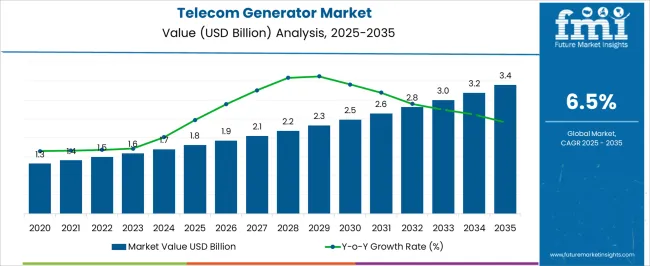
| Metric | Value |
|---|---|
| Telecom Generator Market Estimated Value in (2025 E) | USD 1.8 billion |
| Telecom Generator Market Forecast Value in (2035 F) | USD 3.4 billion |
| Forecast CAGR (2025 to 2035) | 6.5% |
The telecom generator market is experiencing consistent growth, driven by the rising need for reliable backup power solutions to support telecom infrastructure. With increasing telecom network expansions and the growing demand for uninterrupted connectivity, power stability has become a critical factor. Industry developments and infrastructure projects have emphasized the importance of generators that can provide continuous power during outages and maintain network uptime.
The rising adoption of 4G and 5G technologies has led to an increase in telecom base stations, which require efficient and dependable power backup. Additionally, remote and off-grid locations where grid power is unreliable have further boosted demand for telecom generators.
Future growth is expected to be propelled by investments in energy-efficient generator technologies and expanding telecom networks in developing regions. Segmental demand is expected to be led by power ratings between >50 kVA and 125 kVA, diesel fuel generators, and standby applications.
The telecom generator market is segmented by power rating, fuel type, application, and geographic region. By power rating, the telecom generator market is divided into > 50 kVA - 125 kVA, ≤ 25 kVA, > 25 kVA - 50 kVA, > 125 kVA - 200 kVA, > 200 kVA - 330 kVA, and > 330 kVA. In terms of fuel, the telecom generator market is classified into Diesel and Gas. Based on the application, the telecom generator market is segmented into Standby and Prime/Continuous. Regionally, the telecom generator industry is classified into North America, Latin America, Western Europe, Eastern Europe, Balkan & Baltic Countries, Russia & Belarus, Central Asia, East Asia, South Asia & Pacific, and the Middle East & Africa.
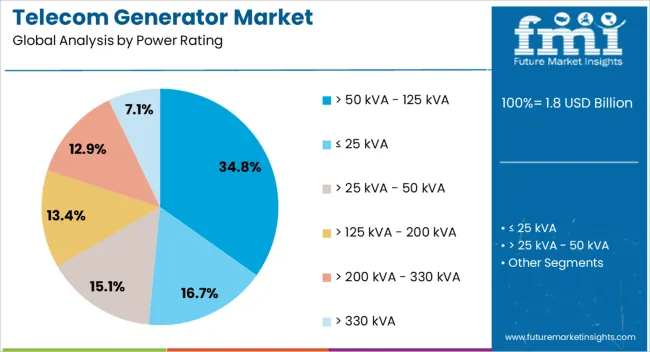
The > 50 kVA - 125 kVA power rating segment is projected to contribute 34.8% of the telecom generator market revenue in 2025, maintaining its dominance in this category. This power range is favored for medium-sized telecom facilities, offering an optimal balance between capacity and fuel efficiency.
Telecom operators have preferred this segment due to its ability to reliably support multiple base stations and network equipment during power interruptions. Its versatility and relatively compact design allow it to be installed in diverse site conditions.
Moreover, this power rating has become standard for many telecom infrastructure projects, particularly in urban and semi-urban areas where power demand is moderate but critical. The segment is expected to sustain growth as network densification and rural connectivity projects expand.
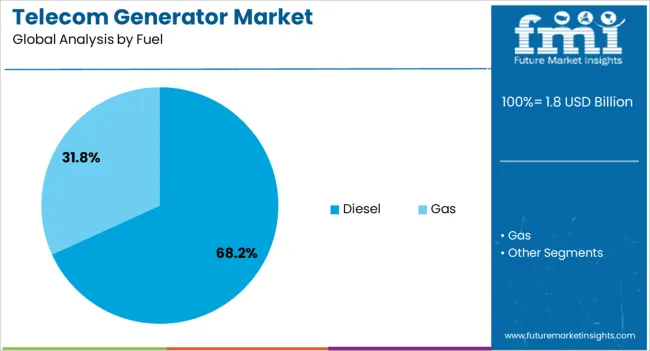
The Diesel fuel segment is projected to hold 68.2% of the telecom generator market revenue in 2025, positioning it as the leading fuel type. Diesel generators have remained the preferred choice in telecom due to their reliability, fuel availability, and cost-effectiveness for backup power applications.
The fuel’s high energy density ensures longer runtime during outages, which is critical for maintaining telecom network uptime. Despite growing interest in alternative energy sources, diesel continues to dominate because of existing infrastructure and familiarity among operators.
Additionally, diesel generators can handle variable loads efficiently, which is essential for telecom equipment that may have fluctuating power demands. The segment is expected to retain its leadership as improvements in emission standards and fuel efficiency are adopted.
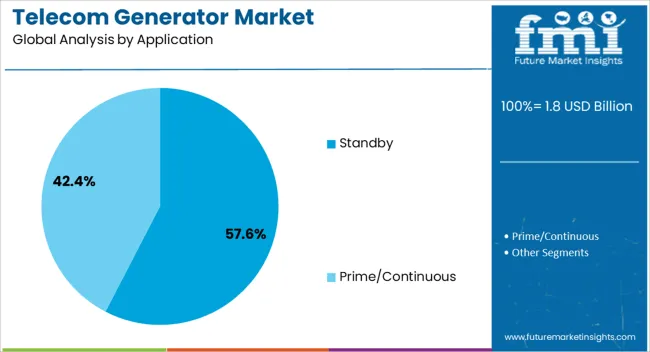
The Standby application segment is projected to represent 57.6% of the telecom generator market revenue in 2025, establishing it as the primary application type. Standby generators provide emergency power during grid failures, ensuring continuous operation of telecom networks.
The critical nature of telecommunications services demands reliable standby power solutions to avoid downtime and service interruptions. Telecom companies have increasingly prioritized standby generators equipped with automatic transfer switches and remote monitoring for rapid response.
The segment growth is also fueled by regulatory requirements mandating backup power for telecom infrastructure. As telecom networks expand and become more complex, the demand for efficient standby generators capable of quick start-up and reliable operation is expected to grow steadily.
The market has been expanding due to the growing demand for reliable power backup solutions in telecommunication networks, data centers, and mobile towers. Telecom generators have been widely used to ensure uninterrupted operations during power outages, grid failures, and peak energy demand. Market growth has been supported by advances in fuel-efficient engines, low-emission technologies, and remote monitoring capabilities. Rising deployment of 4G and 5G networks, increasing mobile subscriber base, and the expansion of telecom infrastructure have further strengthened the adoption of telecom generators globally.
The need for uninterrupted power supply to telecom networks has been a primary driver of the telecom generator market. Mobile towers, base stations, and data centers require stable power to prevent service disruptions and maintain communication reliability. Generators equipped with advanced engines, automatic transfer switches, and fuel management systems have been deployed to provide backup during grid failures or peak load conditions. Telecom operators have increasingly relied on hybrid solutions combining diesel, natural gas, and battery storage to reduce downtime. The growth of high-speed 4G and 5G networks has intensified the need for reliable energy solutions, prompting the adoption of generators that can sustain continuous operation under varying environmental conditions, especially in remote or underdeveloped regions.
Technological innovations have significantly enhanced the efficiency, reliability, and monitoring of telecom generators. Advanced fuel-efficient engines, low-emission combustion systems, and hybrid generator designs have optimized energy use while minimizing operational costs. Remote monitoring, IoT-enabled controls, and predictive maintenance solutions have enabled operators to track generator performance in real time, detect potential faults, and schedule timely servicing. Automation of start-stop cycles, load sharing, and energy optimization features has improved reliability and reduced fuel consumption. These advancements have ensured that telecom networks remain operational during outages while complying with environmental regulations. The integration of smart monitoring platforms has also supported proactive maintenance and energy management, making generators more suitable for modern telecom infrastructure.
Compliance with environmental and emission regulations has been a major factor driving the deployment of advanced telecom generators. Governments and environmental agencies have established limits for diesel and gas generator emissions, noise levels, and fuel efficiency. Manufacturers have adopted cleaner fuels, emission control technologies, and certified low-noise enclosures to meet these standards. The telecom operators are increasingly investing in green backup solutions, combining generators with solar energy or battery storage to reduce carbon footprint. Regulatory frameworks have also promoted the installation of generators in compliance with safety and operational guidelines, ensuring minimal disruption to network operations and public health. These regulations have driven innovation in cleaner, more efficient telecom generator systems globally.
The rapid deployment of 5G networks and expansion of telecom infrastructure in urban and remote areas have created significant opportunities for the telecom generator market. 5G base stations and edge computing hubs demand higher energy consumption and reliable backup systems, increasing the need for robust generators. Remote locations with limited grid connectivity have further emphasized the importance of dependable power solutions. Hybrid systems combining renewable energy with conventional generators are being adopted to reduce fuel costs and environmental impact. The growing number of mobile subscribers and data-intensive applications have increased operational energy requirements. As network coverage and digital services continue to expand globally, the demand for advanced, fuel-efficient, and reliable telecom generators is expected to grow steadily across the market.
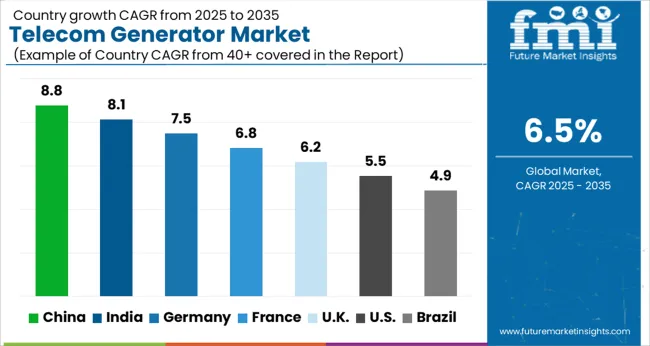
The market is projected to expand at a CAGR of 6.5% between 2025 and 2035, driven by the increasing need for uninterrupted power supply in telecommunications, growing network expansions, and adoption of hybrid power solutions. China leads with an 8.8% CAGR, supported by extensive telecom infrastructure development and rural network electrification. India follows at 8.1%, fueled by rising mobile connectivity and 5G rollout. Germany, at 7.5%, benefits from reliable power backup requirements and modern telecom infrastructure. The UK, with a 6.2% CAGR, focuses on resilient network power systems, while the USA, at 5.5%, shows steady growth through telecom operator upgrades and energy-efficient generator deployment. This report includes insights on 40+ countries; the top markets are shown here for reference.
The industry in China is expected to advance at a CAGR of 8.8% from 2025 to 2035, driven by large-scale expansion of mobile and fiber networks and demand for uninterrupted power in remote installations. Domestic manufacturers have focused on hybrid diesel and natural gas units to enhance reliability and efficiency. Strategic collaborations between generator producers and telecom operators are improving maintenance and service turnaround. Investments in modular and portable units are increasing adoption in tower sites across challenging terrains. Energy efficiency and compliance with emissions regulations remain central to product development, ensuring competitiveness in the domestic and export markets.
The adoption of telecom generators in India is projected to expand at a CAGR of 8.1% from 2025 to 2035, supported by network densification and rural electrification initiatives. Manufacturers are focusing on cost-effective and fuel-efficient models to meet rising demand from telecom operators. Modular and containerized generators are gaining traction for deployment in small and medium tower sites. Emphasis on reliability and long operational lifespans has led to increasing adoption of smart monitoring and predictive maintenance solutions. Public-private partnerships are accelerating infrastructure development in remote regions, strengthening market potential.
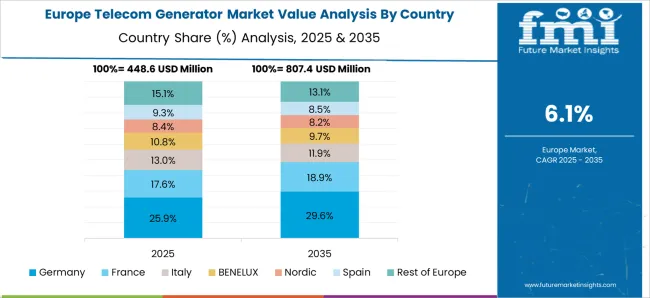
The market in Germany is expected to grow at a CAGR of 7.5% from 2025 to 2035, fueled by industrial automation, data center expansions, and strict reliability standards for telecom infrastructure. Manufacturers are adopting digital monitoring systems to provide predictive maintenance and energy management. Demand for compact and low-noise generators is increasing in urban tower installations. Partnerships between energy providers and telecom operators have enhanced grid support during outages. Compliance with stringent environmental regulations drives innovation in low-emission generator designs, supporting steady market growth.
The United Kingdom telecom generator industry is projected to advance at a CAGR of 6.2% from 2025 to 2035, supported by network modernization and deployment of 5G towers. Manufacturers are emphasizing lightweight, modular, and fuel-efficient designs for urban and suburban sites. Integration of smart control and remote monitoring technologies is increasing adoption, while partnerships with telecom operators optimize service intervals and performance. Replacement and retrofit projects of legacy generators are also contributing to sales, ensuring network continuity during outages.
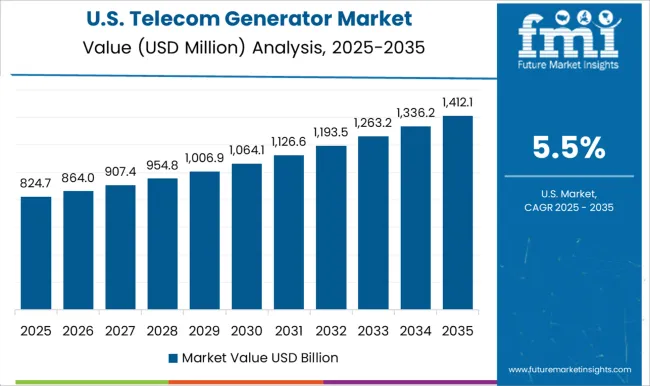
The United States market is expected to grow at a CAGR of 5.5% from 2025 to 2035, driven by expansion of rural broadband and 5G infrastructure. Manufacturers are focusing on diesel-electric hybrid units and modular designs for scalable deployment. Government incentives for energy-efficient backup power solutions are supporting adoption. Predictive maintenance and remote monitoring solutions are becoming industry standards to reduce downtime and operational costs. Demand is also rising from data centers and emergency services requiring uninterrupted power support.
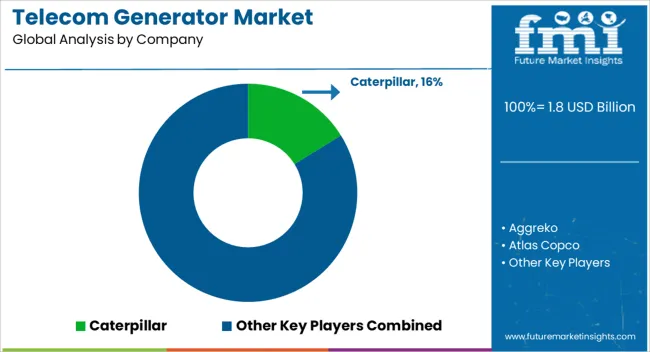
The market supports uninterrupted power supply for telecom towers, data centers, and network infrastructure, especially in regions with unreliable grid access. Caterpillar leads with robust diesel and gas-powered generators designed for high reliability, long service intervals, and remote monitoring capabilities. Aggreko offers modular, scalable solutions that enable rapid deployment and flexible power management for telecom operators. Atlas Copco integrates advanced engine technology and noise-reduction features, catering to urban and sensitive installations. Cummins emphasizes fuel-efficient designs and telematics-enabled monitoring systems to reduce operational costs and downtime. Deere & Company provides durable power solutions optimized for diverse climates and load requirements, while Depco Power Systems delivers compact generators tailored for tower sites. FG Wilson and Generac Power Systems focus on customizable configurations and remote diagnostics. HIMOINSA and Kirloskar Electric Company emphasize localized support and service networks, ensuring rapid maintenance. MAHINDRA POWEROL, PAI KANE GROUP, Perkins Engines Company, Rhelko, Starkgen, and Wartsila contribute with specialized generators designed for both diesel and gas applications, meeting international emission standards. Market strategies revolve around product innovation, strategic partnerships with telecom operators, and service network expansion. Entry barriers include high capital investment, regulatory compliance, and technical expertise in generator design and maintenance. Companies delivering reliable, efficient, and low-maintenance generators are positioned to dominate long-term market growth in the telecom sector.
| Item | Value |
|---|---|
| Quantitative Units | USD 1.8 Billion |
| Power Rating | > 50 kVA - 125 kVA, ≤ 25 kVA, > 25 kVA - 50 kVA, > 125 kVA - 200 kVA, > 200 kVA - 330 kVA, and > 330 kVA |
| Fuel | Diesel and Gas |
| Application | Standby and Prime/Continuous |
| Regions Covered | North America, Europe, Asia-Pacific, Latin America, Middle East & Africa |
| Country Covered | United States, Canada, Germany, France, United Kingdom, China, Japan, India, Brazil, South Africa |
| Key Companies Profiled | Caterpillar, Aggreko, Atlas Copco, Cummins, Deere & Company, Depco Power Systems, FG Wilson, Generac Power Systems, HIMOINSA, Kirloskar Electric Company, MAHINDRA POWEROL, PAI KANE GROUP, Perkins Engines Company, Rhelko, Starkgen, and Wartsila |
| Additional Attributes | Dollar sales by generator type and capacity, demand dynamics across telecom towers, data centers, and network hubs, regional trends in adoption across Asia-Pacific, North America, and Europe, innovation in fuel efficiency, hybrid power integration, and remote monitoring systems, environmental impact of emissions, fuel consumption, and equipment lifecycle, and emerging use cases in 5G network backup, off-grid connectivity, and renewable-powered telecom infrastructure. |
The global telecom generator market is estimated to be valued at USD 1.8 billion in 2025.
The market size for the telecom generator market is projected to reach USD 3.4 billion by 2035.
The telecom generator market is expected to grow at a 6.5% CAGR between 2025 and 2035.
The key product types in telecom generator market are > 50 kva - 125 kva, ≤ 25 kva, > 25 kva - 50 kva, > 125 kva - 200 kva, > 200 kva - 330 kva and > 330 kva.
In terms of fuel, diesel segment to command 68.2% share in the telecom generator market in 2025.






Our Research Products

The "Full Research Suite" delivers actionable market intel, deep dives on markets or technologies, so clients act faster, cut risk, and unlock growth.

The Leaderboard benchmarks and ranks top vendors, classifying them as Established Leaders, Leading Challengers, or Disruptors & Challengers.

Locates where complements amplify value and substitutes erode it, forecasting net impact by horizon

We deliver granular, decision-grade intel: market sizing, 5-year forecasts, pricing, adoption, usage, revenue, and operational KPIs—plus competitor tracking, regulation, and value chains—across 60 countries broadly.

Spot the shifts before they hit your P&L. We track inflection points, adoption curves, pricing moves, and ecosystem plays to show where demand is heading, why it is changing, and what to do next across high-growth markets and disruptive tech

Real-time reads of user behavior. We track shifting priorities, perceptions of today’s and next-gen services, and provider experience, then pace how fast tech moves from trial to adoption, blending buyer, consumer, and channel inputs with social signals (#WhySwitch, #UX).

Partner with our analyst team to build a custom report designed around your business priorities. From analysing market trends to assessing competitors or crafting bespoke datasets, we tailor insights to your needs.
Supplier Intelligence
Discovery & Profiling
Capacity & Footprint
Performance & Risk
Compliance & Governance
Commercial Readiness
Who Supplies Whom
Scorecards & Shortlists
Playbooks & Docs
Category Intelligence
Definition & Scope
Demand & Use Cases
Cost Drivers
Market Structure
Supply Chain Map
Trade & Policy
Operating Norms
Deliverables
Buyer Intelligence
Account Basics
Spend & Scope
Procurement Model
Vendor Requirements
Terms & Policies
Entry Strategy
Pain Points & Triggers
Outputs
Pricing Analysis
Benchmarks
Trends
Should-Cost
Indexation
Landed Cost
Commercial Terms
Deliverables
Brand Analysis
Positioning & Value Prop
Share & Presence
Customer Evidence
Go-to-Market
Digital & Reputation
Compliance & Trust
KPIs & Gaps
Outputs
Full Research Suite comprises of:
Market outlook & trends analysis
Interviews & case studies
Strategic recommendations
Vendor profiles & capabilities analysis
5-year forecasts
8 regions and 60+ country-level data splits
Market segment data splits
12 months of continuous data updates
DELIVERED AS:
PDF EXCEL ONLINE
Gas Telecom Generator Market Size and Share Forecast Outlook 2025 to 2035
Prime Telecom Generator Market Size and Share Forecast Outlook 2025 to 2035
Standby Telecom Generator Market Size and Share Forecast Outlook 2025 to 2035
Diesel Fired Telecom Generator Market Size and Share Forecast Outlook 2025 to 2035
Telecom Site Management Software Market Size and Share Forecast Outlook 2025 to 2035
Generator Bushing Market Size and Share Forecast Outlook 2025 to 2035
Telecom Tower Power System Market Size and Share Forecast Outlook 2025 to 2035
Telecom Mounting Hardware Market Size and Share Forecast Outlook 2025 to 2035
Telecom Billing And Revenue Management Market Size and Share Forecast Outlook 2025 to 2035
Telecom Testing Equipment Market Size and Share Forecast Outlook 2025 to 2035
Telecom Analytics Market Size and Share Forecast Outlook 2025 to 2035
Telecom Internet Of Things (IoT) Market Size and Share Forecast Outlook 2025 to 2035
Telecom Tower Power System Market Analysis - Size, Share, and Forecast Outlook 2025 to 2035
Generator Sales Market Size and Share Forecast Outlook 2025 to 2035
Telecom Network Infrastructure Market Analysis - Size, Share, and Forecast Outlook 2025 to 2035
Telecom Power Rental Market Size and Share Forecast Outlook 2025 to 2035
Telecom Millimeter Wave Technology Market Size and Share Forecast Outlook 2025 to 2035
Generator Sets Market Size and Share Forecast Outlook 2025 to 2035
telecom-expense-management-market-market-value-analysis
Telecom Order Management Market Size and Share Forecast Outlook 2025 to 2035

Thank you!
You will receive an email from our Business Development Manager. Please be sure to check your SPAM/JUNK folder too.
Chat With
MaRIA